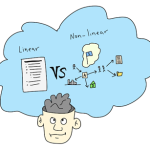Do you have a link to that BusinessThink book you mentioned? It relates to a project I’m working on right now!
Here’s a Quick Way to Define Rapid E-Learning
August 29th, 2007
Last week, I posted the question, “How do you define rapid e-learning?” The community responded and today we have over 200 definitions. We even got one from former U.S. Vice-President, Al Gore, who claimed to have “invented rapid e-learning.” I suspect that one’s not real.
What I really enjoyed about reading these definitions is that they were submitted by e-learning professionals from all over the world. In a recent post, marketing guru, David Meerman Scott, discussed how the Internet has allowed communication to come full circle, giving us a virtual town square where we can have “communication that is personal and authentic.”
Something like this wasn’t possible just a few years ago. The Internet allows us to connect and build our own virtual town square where we are able to share our ideas and best practices. It’s something we see in the e-learning community where people answer questions, share ideas, and their project files.
It is interesting to read the definitions of rapid e-learning and see the diversity of opinion. While there are many similarities in the definitions they do cover a broad spectrum. Some focused on the technology and cost, while others focused on the learner. There are even a few who challenged the effectiveness of rapid e-learning. How is it possible that there can be so many definitions?
Clear communication is essential for the e-learning industry that is focused on teaching others.
Trying to define rapid e-learning makes this challenge clear. It is evident that while we use the same words, we might not mean the same things. This is compounded when you consider the many nationalities and cultures that make up the town square.
In the book, BusinessThink, the authors discuss “complex equivalents.” They say that as we present our ideas we use words that have encoded meaning. Like an iceberg, the words float on top, yet below the surface lurk multiple meanings and interpretations that require further exploration and clarification if communication is to be real.

I found this to be true with our definitions of rapid e-learning. One person might define it as “the technology used to create inexpensive training” while another definition might be “the ability to create training on-the-fly to meet very immediate needs.” They both are valid, yet mean two different things.
What Is the Definition of Rapid E-Learning?
I am sure that this contest will not settle the definition of rapid e-learning. However, I know it has contributed to the conversation in our virtual town square.
Now for the task at hand…
We had over 200 submissions and I needed to pare that down to 5 for our poll. Here’s what I did: to trim the definitions to a manageable number, I read through them a few times. I did this to identify the most common definitions. From there I trimmed the list down to those that used the fewest words. The remaining definitions were very similar although they each had unique nuances. To come up with the final five I took it to the lab and ran it through my trusted definition analyzer.
Here are the final five. Click on the survey link to cast your vote. I’ll keep the polls open until the end of the week. [Editor’s note: voting is closed]
Events
- Everyday. Check out the weekly training webinars to learn more about Rise, Storyline, and instructional design.
Free E-Learning Resources
 |
 |
 |
|
Want to learn more? Check out these articles and free resources in the community. |
Here’s a great job board for e-learning, instructional design, and training jobs |
Participate in the weekly e-learning challenges to sharpen your skills |
 |
 |
 |
|
Get your free PowerPoint templates and free graphics & stock images. |
Lots of cool e-learning examples to check out and find inspiration. |
Getting Started? This e-learning 101 series and the free e-books will help. |
21 responses to “Here’s a Quick Way to Define Rapid E-Learning”
I’d like to see all 200 definitions submitted. Will you be publishing those?
It seems as if we may be confusing Rapid e-Learning with Just-in-Time e-Learning. In my experience, people are usually referring to rapid DEVELOPMENT when they speak of “Rapid e-Learning.” When they want to talk about delivering information (often in small doses) at mission-critical times, they describe that as “Just-in-Time,” or “JIT.”
JIT learning is, I think, an up-and-coming area in our profession. As more and more people get used to technology such as podcasts and RSS feeds, I think we’ll be able to deliver small, highly relevant, content on an as-needed basis.
Tom, and thus the value of REL! It’s a perfect fit in today’s ever-changing business environment.
Looking at these definitions I can’t see what ‘Rapid’ adds to the offer. It’s like saying ‘good’ or ‘nice’. More rapid than what? What is the alternative to Rapid – is it ‘slow’ or is it ‘thorough’ or ‘painstaking’?
From what I pick up it seems to refer to both a toolset and a willingness to shortcut stages in the development process that we ‘inherited’ from IT project development. So an analogy with desktop publishing might be that ‘Rapid’ is DTP whereas non-Rapid is full-on professional publishing?
Norman:
Heaven forbid that the definition of “rapid” would be “shoddy.”
I think what we’re talking about here is finding ways to quickly deliver high-quality e-learning (often to a large audience).
In the past (like in the early 90’s when I started in this field) we could take months to develop training. Companies retained the same processes, and we could develop the training once and use it for years.
Today, the climate has evolved to the degree that we need to respond rapidly to change, and fill performance gaps quickly. In addition to this evolution, budgets continue to shrink as companies strive to stay competitive. That means we need to get more done with less people in less time — but it still needs to be effective and deliver measurable performance improvements.
Maybe the opposite of “Rapid” is “Permanent,” or “Big Budget.” If you’re in an industry that has little change over long periods of time, or one that has an unlimited budget, consider it a luxury!
I totally agree with Norman that Rapid eLearning refers to taking risks in the development process and cutting corners.
If the outcome is in the same quality as in the “regular” elearning, why would any professional concerned with budgeting (and I hope most of us are) use the “regular” one?
As Tom says, I didn’t mean that not using ADDIE was a bad thing. I’ve been a customer to a few companies developing with ADDIE as well as a developer and I’ve never been convinced about the strict ‘sign off this stage before moving on’ approach, for a number of reasons. And I’ve usually found that the nearer you come to the deadline, the less strictly it’s followed. So REL may be a recognition that progress can be made on the basis of prototyping and trust. The approach I’m taking (as a corporate in-house developer) is to create templates that embody some elements of instructional design and coach subject experts to use them, in the hope that some will be able to produce good material by themselves. We just work with text and graphics, no audio or video so it’ll be easier for us than some of you. I’ve written on my own blog about a possible ‘minimum level’ of ID. I’d also characterise REL as a willingness to say ‘yes, a single page or a short non-interactive page-turner might be sufficient here’, which chimes with Rissa’s point about JIT.
I agree with Rissa’s first comment that some people are confusing Rapid e-Learning with Just-in-Time e-Learning. But as Tom said, some people are using Rapid e-Learning tools to develop Just-in-Time training. But they are two distinct items.
For me, rapid e-learning is about the tools used to develop the e-learning solution and the process that supports using those tools.
In traditional Computer-Based Training (CBT) development, an instructional designer works with a subject matter expert to create storyboards for a course in MS Word or Powerpoint. They send the completed storyboards to a developer who follows the storyboards to create interactive training using a product such as ToolBook, Authorware, or Flash. Today, a WBT can also be custom developed with HTML, XML. JavaScript, and CSS. Many organizations built their own “engine” that would provide much of the foundation such as navigation, bookmarking, and testing functions that reduced the level of effort required to develop training. Even if the developer had access to a library of widgets, the course would require some custom programming.
Rapid e-Learning products like Articulate provide a pre-built template and interface that handles all of the issues related to navigation, LMS tracking, and interactions. When you move from the traditional tools to a product such as Articulate, the instructional designer and subject matter experts can design the course in PowerPoint. They can use Articulate Engage and Quizmaker to create interactive presentations and quizes. When done, they can publish the content for the internet without needing the programmer to get involved. This saves a major step in the development process which is why it is more rapid.
The fact that you are developing the training with a rapid e-learning development tool does not mean that you should also shortcut the instructional design process. You still need to design training that meets the needs of your client and their learners. Remember, one poorly designed training program can turn a student off from future e-learning courses.
Tom, I’m 35 and I remember green screen computers! We are indeed in for some cool stuff down the road.
“Rapid elearning.” Hmm…we have ‘elearning’ and we have ‘rapid,’ where ‘rapid’ is an adjective that tells us what kind of elearning it is. Doesn’t it follow that the correct structure, at least, of the definition must be “Rapid elearning is elearning that is rapid”? So once we have the definitions for ‘elearning’ and ‘rapid’ we simply insert them as:
“Rapid elearning is [definition of elearning] that is [what is meant by ‘rapid’].”
Do we really not know what the ‘rapid’ means? Is it not obvious that it refers to rapid development? Why isn’t the definition simply “Rapid elearning is elearning that is built/created/produced rapidly”? (take your pick on the verb, they all work).
Once we have that, it’s really a question of what is “elearning”, is it not? And that seems to be where much of the divergence occurs in the submitted definitions (apart from the rapid development versus just-in-time discussion, of course).
But are we really trying to debate and define “elearning”? Wouldn’t that have been a blog discussion 5-8 years ago. You’d think we are all more or less agreed as to what elearning is (though this survey tells us otherwise apparently). Yet much of the 5 final definitions try to describe elearning, and don’t even do a very good job of that.
Take one of the five final definitions, for instance:
“Rapid elearning delivers the right educational material at the right level at the right time to the right person in the right manner, with measurable results.”
First of all, this is not really a definition. It does not say what it is, but rather what it does (or what we’d like to think it does). Too picky? Perhaps, but if we can’t be clear and accurate amongst ourselves…
Second, does that description (about delivering the right everything to the right everyone) even hint at anything that is ‘rapid’ or that is ‘elearning’? Does it give any unique attributes to ‘elearning’ or to ‘rapid’? You can quickly tell if a definition is not accurate if you can replace the term with another term and the definition still works (or works better, as it does in this case). You could insert “Training” or “Instructional Design” or “The ADDIE Process” and the definition makes more sense:
“[Instructional design] delivers the right educational material at the right level at the right time to the right person in the right manner, with measurable results.”
Or, to my point earlier, it should say “The goal of Instructional Design is to deliver the right…”
That definition is clearly for something much more broad than even “elearning”, much less “rapid elearning”.
This is why I prefer “Rapid elearning is elearning that was created rapidly.”
However, this doesn’t capture all probably meanings because when we say “rapid elearning” we are not just referring to the thing as an object or end product that was built rapidly, we also see it as the process–how it was built. It’s a development approach. That’s why we can say, “I’m doing rapid elearning” or “this is a tool for rapid elearning.” It seems we use “rapid elearning” as a verb, too.
To conclude, because I’m not thrilled with any of the 5 final definitions, I’ll suggest my own:
“Rapid elearning is elearning that was developed in a much shorter period of time than has been typical. It also refers to the process or approach by which elearning is developed more quickly.” And obviously, there are tools, such as Articuate, that endeavor to make such a process or approach possible.
that was very nice
[…] Rapid eLearning Blog Comment – Scroll down to the August 31st, 2007 […]
Hi
I was wondering if you posted the winning definition for rapid eLearning?
If so where can it be found?
Thanks
David









0
comments